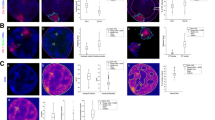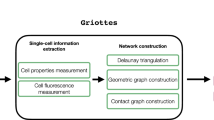Abstract
Analysis of microscopy images can provide insight into many biological processes. One particularly challenging problem is cellular nuclear segmentation in highly anisotropic and noisy 3D image data. Manually localizing and segmenting each and every cellular nucleus is very time-consuming, which remains a bottleneck in large-scale biological experiments. In this work, we present a tool for automated segmentation of cellular nuclei from 3D fluorescent microscopic data. Our tool is based on state-of-the-art image processing and machine learning techniques and provides a user-friendly graphical user interface. We show that our tool is as accurate as manual annotation and greatly reduces the time for the registration.





Similar content being viewed by others
References
Santella, A., Du, Z., Nowotschin, S., Hadjantonakis, A., Bao, Z.: A hybrid blob-slice model for accurate and efficient detection of fluorescence labeled nuclei in 3D. BMC Bioinformatics 11(1), 580–2010 (2010)
Li, G., Liu, T., Tarokh, A., Nie, J., Guo, L., Mara, A., Holley, S., Wong, S.: 3D cell nuclei segmentation based on gradient flow tracking. BMC Cell Biol. 8(1), 40 (2007)
Coelho, L.P., Shariff, A., Murphy, R.F.: Nuclear segmentation in microscope cell images: a hand-segmented dataset and comparison of algorithms. In IEEE International Symposium on Biomedical Imaging: From Nano to Macro, (2009)
Cremers, D., Rousson, M., Deriche, R.: A review of statistical approaches to level set segmentation: integrating color, texture, motion and shape. Int. J. Comput. Vis. 72(2), 195–215 (2007)
Dufour, A., Shinin, V., Tajbakhsh, S., et al.: Segmenting and tracking fluorescent cells in dynamic 3-D microscopy with coupled active surfaces. IEEE Trans. Image Process. 14(9), 13961410 (2005)
Srinivasa, G., Fickus, M.C., Guo, Y., et al.: Segmenting and tracking fluorescent cells in dynamic 3-D microscopy with coupled active surfaces. IEEE Trans. Image Process. 18(8), 1817–1829 (2009)
Boykov, Y., Funka-Lea, G.: Graph cuts and efficient ND image segmentation. Int. J. Comput. Vis. 70(2), 109–131 (2006)
Al-Kofahi, Y., Lassoued, W., Lee, W., et al.: Improved automatic detection and segmentation of cell nuclei in histopathology images. IEEE Trans. Biomed. Eng. 57(4), 841–852 (2010)
Heinrich, S., Geissen, E., Kamenz, J., Trautmann, S., Widmer, C., Drewe, P., Knop, M., Radde, N., Hasenauer, J., Hauf, S.: Determinants of robustness in spindle assembly checkpoint signalling. Nat. Cell Biol. 15(11), 1328–1339 (2013)
Pécot, T., Singh, S., Caserta, E., Huang, K., Machiraju, R., Leone, G.: Non parametric cell nuclei segmentation based on a tracking over depth from 3D fluorescence confocal images. In 9th IEEE International Symposium on Biomedical Imaging (ISBI), 170–173, (2012)
Uzunbas, M.G., Soldea, O., Unay, D., Cetin, M., Unal, G., Ercil, A., Ekin, A.: Coupled nonparametric shape and moment-based intershape pose priors for multiple basal ganglia structure segmentation. IEEE Trans. Med. Imaging 29(12), 1959–1978 (2010)
Stegmaier, J., Otte, J.C., Kobitski, A., Bartschat, A., Garcia, A., Nienhaus, G.U., Strähle, U., Mikut, R.: Fast segmentation of stained nuclei in terabyte-scale, time resolved 3D microscopy image stacks. PloS One 9(2), e90036 (2014)
Svoboda, D., Kozubek, M., Stejskal, S.: Generation of digital phantoms of cell nuclei and simulation of image formation in 3D image cytometry. Cytometry A 75(6), 494–5099 (2009)
Lou, X., Kang, M., Xenopoulos, P., Muñoz-Descalzo, S., Hadjantonakis, A.K.: A rapid and efficient 2D/3D nuclear segmentation method for analysis of early mouse embryo and stem cell image data. Stem Cell Reports 2(3), 382–397 (2014)
Mitchell I.M.: A toolbox of level set methods. In UBC Department of Computer Science Technical Report, TR-2007-11, (2007)
Wienert, S., Heim, D., Saeger, K., Stenzinger, A., Beil, M., Hufnagl, P., Dietel, M., Denkert, C., Klauschen, F.: Detection and segmentation of cell nuclei in virtual microscopy images: a minimum-model approach. Sci. Rep. 2, 503 (2012)
Evgeniou, T., Micchelli, C.A., Pontil, M.: Learning multiple tasks with kernel methods. J. Mach. Learn. Res. 6(1), 615–637 (2005)
Lou, X., Koethe, U., Wittbrodt, J., Hamprecht, F. A.: Learning to segment dense cell nuclei with shape prior. In CVPR (2012)
Gonzalez, R.C., Woods, R.E.: Digital Image Processing. Prentice Hall, Upper Saddle River (2008)
Lou, X., Koethe, U., Wittbrodt, J., Hamprecht, F.A.: Improved automatic detection and segmentation of cell nuclei in histopathology images. In IEEE on Computer Vision and Pattern Recognition (CVPR)(2012)
Weisstein, E. W.: “Ellipse”. From MathWorld—A Wolfram Web Resource. http://mathworld.wolfram.com/Ellipse.html
Rosin, P.L.: Assessing error of fit functions for ellipses. Graph. Models Image Process. 58(5), 494–502 (1996)
Fitzgibbon, A., Pilu, M., Fisher, R.B.: Direct least square fitting of ellipses. IEEE Trans. Pattern Anal. Mach. Intell. 21(5), 476–480 (1999)
Newcomb, S.: A generalized theory of the combination of observations so as to obtain the best result. Am. J. Math. 8, 343–366 (1886)
Huber, P.J.: The 1972 wald lecture robust statistics: a review. Ann. Math. Stat. 43(4), 1041–1067 (1972)
Vapnik, V.: The Nature of Statistical Learning Theory. Volume 8 of Statistics for Engineering and Information Science. Springer, Berlin (1995)
Smola, A. J., Schölkopf, B.: Learning with Kernels: Support Vector Machines, Regularization, Optimization, and Beyond. Volume 64 of Adaptive Computation and Machine Learning. MIT Press, Cambridge (2001)
Smola, A.J., Schölkopf, B.: A tutorial on support vector regression. Stat. Comput. 14(3), 199–222 (2004)
Boyd, S., Vandenberghe, L.: Convex Optimization. Cambridge University Press, Cambridge (2004)
Widmer, C., Kloft, M., Görnitz, N., Rätsch, G.: Efficient training of graph-regularized multitask SVMs. In ECML2012, pp. 633–647, Springer, Berlin (2012)
Fischler, M.A., Bolles, R.C.: Random sample consensus: a paradigm for model fitting with applications to image analysis and automated cartography. Commun. ACM 24.6, 381–395 (1981)
Elsasser, W.M.: Outline of a theory of cellular heterogeneity. In Proceedings of the National Academy of Sciences, 5126–5129, (1984)
Li, G., Liu, T., Tarokh, A., et al.: 3D cell nuclei segmentation. BMC Cell Biol. 8(1), 40 (2007)
Acknowledgments
We gratefully acknowledge core funding from the Sloan Kettering Institute (to G.R.), from the Ernst Schering foundation (to S.H.) and from the Max Planck Society (to G.R. and S.H.). Part of this work was done while C.W., S.H., P.D. and G.R. were at the Friedrich Miescher Laboratory of the Max Planck Society and while C.W. was at the Machine Learning Group at TU-Berlin.
Author information
Authors and Affiliations
Corresponding author
Electronic supplementary material
Below is the link to the electronic supplementary material.
Rights and permissions
About this article
Cite this article
Widmer, C., Heinrich, S., Drewe, P. et al. Graph-regularized 3D shape reconstruction from highly anisotropic and noisy images. SIViP 8 (Suppl 1), 41–48 (2014). https://doi.org/10.1007/s11760-014-0694-8
Received:
Revised:
Accepted:
Published:
Issue Date:
DOI: https://doi.org/10.1007/s11760-014-0694-8




